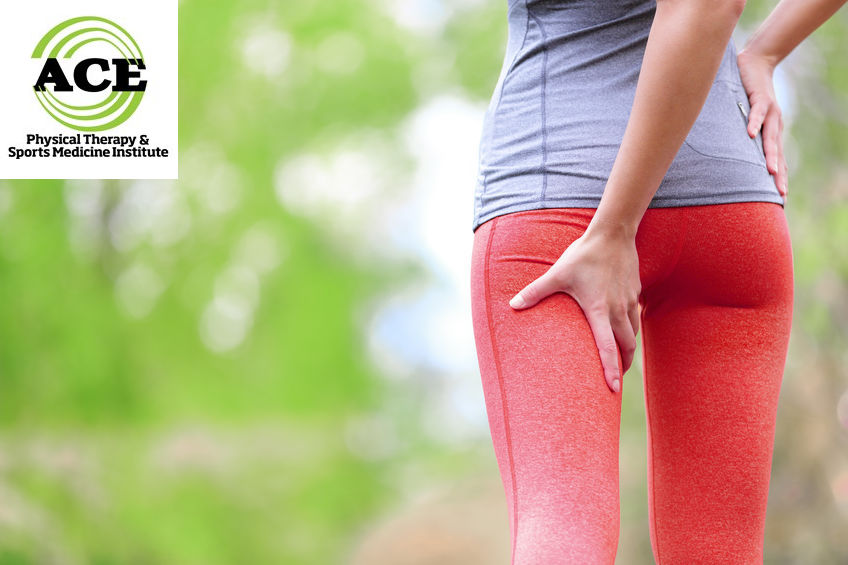PROXIMAL HAMSTRING TENDINOPATHY

Tid Bits of Info
- Three hamstrings originate from the ischial tuberosity and are compressed when the hip is flexed.
- Common symptoms of this condition are an ache and tightness just below the buttocks.
- When the upper hamstring is inflamed the nerves can be irritated and refer the pain down the leg.
- Painful activities should be avoided when experiencing an upper hamstring injury.
- Seek the advice and treatment of a Physical Therapist if you injure your upper hamstring.
If runners or other athletes complain of pain when sitting or pain in upper thigh or deep buttock, they may be suffering from proximal hamstring tendinopathy. While tendon injuries and treatment can be a common experience, upper hamstring injuries may cause long-term pain, inability to compete in sports, and reduction of daily activities. If you have suffered from upper or proximal hamstring pain for several months, you should seek professional care to avoid long term complications.
The hamstring consists of three muscles that originate from the ischial tuberosity and cross the hip and knee joints. There are nerves and arteries in the area of the ischial tuberosity and many upper hamstring injuries also involve nerve irritation. These muscles are designed for speed and can experience significant during certain “explosive” type activities such as running and kicking. The muscles are capable of extending the hip and flexing the knee but can be damaged during activities that cause the hip to flex while the knee is moving into an extended position.
Tendons are remarkably resilient but can be damaged when too much force/load is placed upon it. When a force/load is placed on a tendon the tendon responds by increasing tenocyte and protein synthesis. This production can maintain a healthy tendon or help to heal an acutely injured tendon, but if the force/load is too great the production of tenocytes and protein cannot keep pace and damage occurs. This explains why some athletes and lay people can experience tendon damage either by prolonged loading or instantly if there is excessive loading on a particular tendon during a certain event.
When patients report upper hamstring pain originating just below the buttock, the healthcare professional must rule out other conditions that may present in a similar manner. The patient usually complains of gradually worsening pain and tightness in the area of the hamstring origin or ischial tuberosity (the bone in the pelvis that people sit on). This area is placed under a great compressive force during lunges, squats, deadlifts, sprinting or carrying heavy loads up a hill or stairs. Repeated activity or a single episode of those listed can cause damage to the tendon.
Treatment requires a definitive diagnosis, which is most accurately obtained via an MRI. There are a couple of physical exam tests that the clinician usually performs that assesses the status of the tendon at its origin. When the tendon is stretched and a compressive force is placed on the tendon and ischial tuberosity pain will occur. There also might be pain to palpation.
Treating this condition is multi-faceted. Load management is the first thing that must occur. The injured tendon must be protected. This does not mean that all activities must come to a screeching halt, but anything that causes pain during the activity must be modified or stopped. Participating in an activity that causes pain can cause more damage to the tendon. It may also cause the patient to place too much force on some other structure and cause a “compensatory” injury.

The beginning rehabilitation exercise routine should focus on loading the static tendon. Isometric contractions held for 10-45 seconds have been shown to be effective at safely initiating the healing /strengthening process. The next phase of the strengthening process involves loading the tendon and moving it through a range of motion. The motion should be limited to “relatively” pain-free movement. Exercises that can cause the damage in the first place are great to utilize during this phase providing the load is managed. The final phases of rehabilitation have to include a series of exercises that will begin to restore the resiliency of the tendon and enable it to have the strength and elasticity to handle high loads during life’s activities. Plyometric jumping and agility type activities should be the conclusion of the rehabilitation process.
Seek the advice and treatment of a Physical Therapist if you suspect that you have injured your hamstring. They can evaluate you and design a specific rehabilitation program that will completely rehabilitate the upper hamstring injury.
Tendon injuries are one of the most common injuries/conditions that healthcare professionals treat on a regular basis. If the damaged tendon is treated appropriately it will respond positively in most instances. Proximal hamstring tendinopathy can be difficult to treat, but a comprehensive treatment process should enable the tendon to withstand the forces of that are placed upon it.
























